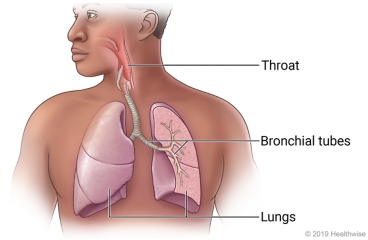Learning About Respiratory Failure
What is respiratory failure?

Your lungs give your body oxygen when you breathe. They also remove the waste product carbon dioxide from
your body. Respiratory failure happens when the lungs aren't able to move enough oxygen into the blood and
move enough carbon dioxide out of the blood. This is a severe problem that may need to be treated in intensive
care.
Many things can cause lung failure. They include pneumonia and other serious infections. The doctor will look
for the cause of the problem and then treat it if possible.
How is it treated?
To help your lungs get enough oxygen, your doctor may use a few devices. These vary in how much oxygen they
give and how they help you breathe. They are:
-
A nasal cannula (say "KAN-yuh-luh"). This is a thin tube with two prongs that fit just inside your nose.
-
A special face mask that delivers more oxygen. There are different kinds. A face mask with a bag on one
end is called a non-rebreather mask.
-
A high-flow nasal cannula. It can warm and wet the oxygen it delivers, so getting high amounts of oxygen
feels better.
-
A face mask that gives you oxygen through a bilevel positive airway pressure (BiPAP) machine. It uses
different air pressures when you breathe in and out.
-
A ventilator that helps you breathe or that breathes for you. It controls how much air and oxygen flow
into your lungs. This machine requires a breathing tube in your windpipe. It can be uncomfortable, so you
may get medicine to help you relax or sleep. You also will get fluid through an intravenous (I.V.) tube.
You will get regular tests to see how much oxygen is in your blood. Tests also can show how well the lungs
are working. These tests help your doctor adjust the machines and the oxygen supply.
The doctor will watch you closely.
Current as of: August 6, 2023
Content Version: 14.0
Care instructions adapted under license by your
healthcare professional. If you have questions about a medical condition or this instruction, always ask
your healthcare professional. Healthwise, Incorporated disclaims any warranty or liability for your use of
this information.